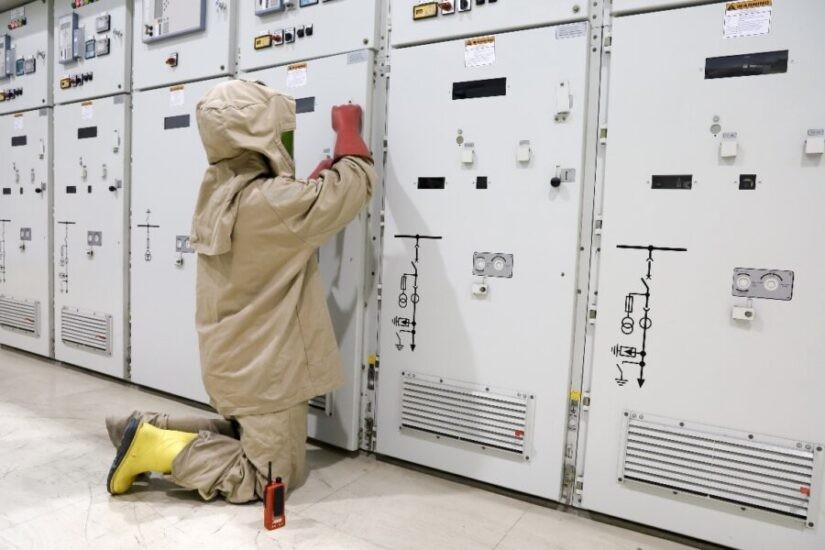Electrical hazards can be some of the most devastating workplace hazards, and unfortunately, they’re also quite common. In order to ensure the safety of everyone on your team, it’s important to conduct regular studies and analyses to identify any potential hazards early on and take action to eliminate any threats.
One common element of a power system analysis is an arc flash study. These studies can be crucial to the safety of your employees, since the potential danger of an arc flash can be devastating, resulting in serious injury or even death. While you should certainly consider having an arc flash study conducted in your workplace, are these studies actually required by law? We’ve outlined everything you should know.
What is an Arc Flash Study?
Before we can define what an arc flash study is, we should quickly talk about what an arc flash is. Sometimes, a luminous bridge can form within the gap between two electrodes. This instance is called an electric arc. When a fault (short circuit condition) passes through that gap, an arc flash occurs.
Arc flashes can happen for a number of reasons, like insufficient equipment, lack of training, or human error when working on live equipment. Even something as simple as a build-up of dust can trigger an arc flash.
An arc flash study, then, is an analysis that serves to identify any pieces of equipment within the workplace that could hold the risk of initiating an arc flash. Arc flash studies typically include elements like short circuit calculations, arc flash hazard calculations, arc flash hazard mitigation, and others.
OSHA Requirements
OSHA does not have a specific requirement mandating that employers have arc flash studies conducted within their workplaces. However, there are a number of OSHA requirements that are a bit broader in terms of protecting workers from electrical hazards.
For instance, 29 CFR 1910.132(d)(1) states, “The employer shall assess the workplace to determine if hazards are present, or are likely to be present, which necessitate the use of personal protective equipment (PPE).” Further regulations set forth guidelines on the distribution of PPE.
Another relevant example is 29 CFR 1910.333(b)(2)(iv)(B), which states, “A qualified person shall use test equipment to test the circuit elements and electrical parts of equipment to which employees will be exposed and shall verify that the circuit elements and equipment parts are deenergized….”
So, while OSHA doesn’t specifically mention arc flash studies within these recommendations, this study can certainly be a step toward meeting these more general requirements.

NFPA 70E Standard for Electrical Safety
One standard that is very clear about the importance of arc flash studies is the NFPA 70E standard. While this standard does not come directly from OSHA, it was created by the National Fire Prevention Association at the request of OSHA. That being said, OSHA does not oversee the enforcement of NFPA 70E, nor is it required by law or is it incorporated within the Code of Federal Regulations.
Essentially, NFPA 70E states that employers should have a plan in place to protect team members from the potential risks of arc flashes and shock hazards. Hazards should be identified and quantified, PPE and sufficient tools should be provided to workers, everyone should be properly trained, and every element of this process should be audited.
Identifying and quantifying the hazards of your workplace is where arc flash studies come into play. Arc flash studies are among the most reliable ways to ensure your workplace is free of hazards or is able to properly address any hazards that may come about.
To be more specific, Article 130.5 of NFPA 70E states that employers are required to conduct an arc-flash risk assessment for their workplace’s electrical equipment. The same article also requires arc-flash labels to be provided and for these labels to indicate “system voltage, arc-flash boundary, and information to determine the minimum arc rating required for the PPE.”
Keep in mind that NFPA 70E is a standard that is not mandated by law. It can be voluntarily adopted by an employer, but in general, local jurisdictions do not adopt it as a broad umbrella that all of their employers must follow. Many employers that choose to adopt NFPA 70E use this standard as a way to ensure they are complying with OSHA standards.
Training for Employee Protection
Thankfully, many of the major causes of arc flashes are due to human error, which means they can be prevented. Training your team members on the proper procedures is one of the easiest ways to reduce the risk of any workplace injury, but especially an arc flash.
NFPA standards require employees who work on or around energized electrical equipment to undergo safety training at least every three years. This interval will help ensure that employees are always aware of the most up-to-date information regarding safety around electrical equipment. This training must also be documented in order to prove compliance.
Additionally, employers must submit their training program to be audited at least every 3 years. The NFPA regularly updates their standards and recommendations, so it’s important to make sure that your training program reflects the most accurate and relevant information for your employees.
Luckily, there are many companies that can perform arc flash training if you don’t have a training program of your own. Classes can often be held either in person or online. Many courses will offer an overview of the latest NFPA 70E standards, while others will focus more specifically on arc flash training.
When it comes to preventing arc flashes, it’s important to ensure that you’re regularly analyzing your equipment and training your employees, even if it’s not mandated by law. To get started, we recommend bringing in an expert to perform an arc flash analysis at your workplace. MTAEE is a NETA accredited company that is proud to serve customers all throughout Southern California. We also perform additional services such as electrical testing, coordination studies, and power system evaluations.
Contact us today to schedule an appointment.

